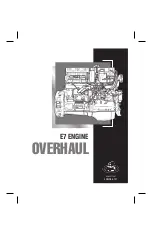
Appendix D
© 2018 Avco Corporation. All Rights Reserved
Page 448
November 2018
TEO-540-C1A Engine Maintenance Manual
Fault ID
192
Fault Group
25
Fault Name
[FAULT: AN23 circuit]
Fault
Description
Primary: EOP (Engine Oil Pressure)
Circuit Fault
Secondary: Engine ID Circuit Fault*
Fault Lamp
TLO
Root Cause
This fault occurs if the Raw voltage observed on the input is outside the expected window
defined by the calibratable Highest and Lowest Valid Raw voltage values.
This does not distinguish between Open and Short Circuit Faults as any of the following
failures would result in the Raw voltage outside the expected voltage window:
-
Open Circuit
-
Short to 5V
-
Short to VPwr
-
Short to GND
Troubleshooting Steps
1.
Run the engine in accordance with the engine and aircraft maintenance manuals. Is the fault active?
If yes, go to step 3. If no, go to step 2.
2.
Using the FST, download active and service fault logs, then clear fault logs and monitor engine
operation for the fault to repeat.
3.
Inspect sensor, and lines for any damage (eg…burned, broken or frayed wires, cracked or broken
connectors or hoses, burned or broken sensors). If damaged, replace the sensor per the “Sensor
Replacement Procedure” in Chapter 72-70. If no damage is found, go to step 4.
4.
Inspect harness connection for any damage (eg…burned, broken or frayed wires, cracked or broken
connectors). Contact Lycoming if harness damage is found. If no damage found, go to step 5.
5.
Complete a continuity test of the harness from the harness sensor connector to the ECU connector using
the engine system schematic. If the continuity check fails, isolate to affected harness by disconnecting
the firewall connection, then contact Lycoming Engines. If the continuity checks good, replace the
sensor. If fault persists, replace the ECU.
*NOTE: If the secondary fault is active, go to troubleshooting procedures for Fault ID 256.
Fault ID
193
Fault Group
25
Fault Name
[FAULT: AN24 circuit]
Fault
Description
Primary: FRP (Fuel Rail Pressure)
Circuit Fault
Secondary: FPP (Fuel Pump Pressure)
Circuit Fault
Fault Lamp
TLO
Root Cause
This fault occurs if the Raw voltage observed on the input is outside the expected window
defined by the calibratable Highest and Lowest Valid Raw voltage values.
This does not distinguish between Open and Short Circuit Faults as any of the following
failures would result in the Raw voltage outside the expected voltage window:
-
Open Circuit
-
Short to 5V
-
Short to VPwr
-
Short to GND
Troubleshooting Steps
1.
Run the engine in accordance with the engine and aircraft maintenance manuals. Is the fault active? If
yes, go to step 3. If no, go to step 2.
2.
Using the FST, download active and service fault logs, then clear fault logs and monitor engine
operation for the fault to repeat.
3.
Inspect sensor, and lines for any damage (eg…burned, broken or frayed wires, cracked or broken
connectors or hoses, burned or broken sensors). If damage is found, replace the damaged part per the
“Sensor Replacement Procedure” in Chapter 72-70. If no damage is found, go to step 4.
4.
Inspect harness connection for any damage (eg…burned, broken or frayed wires, cracked or broken
connectors). Contact Lycoming if harness damage is found. If no damage found, go to step 5.
5.
Swap fuel rail pressure sensor with fuel pump pressure sensor and run the engine. Does the fault move
with the sensor? If yes, replace the sensor. If no, go to step 6.
6.
Complete a continuity test of the harness from the harness sensor connector to the ECU connector using
the engine system schematic. If the continuity check fails, isolate to affected harness by disconnecting
the firewall connection, then contact Lycoming Engines. If the continuity checks good, replace the
sensor. If fault persists, replace the ECU.
















































